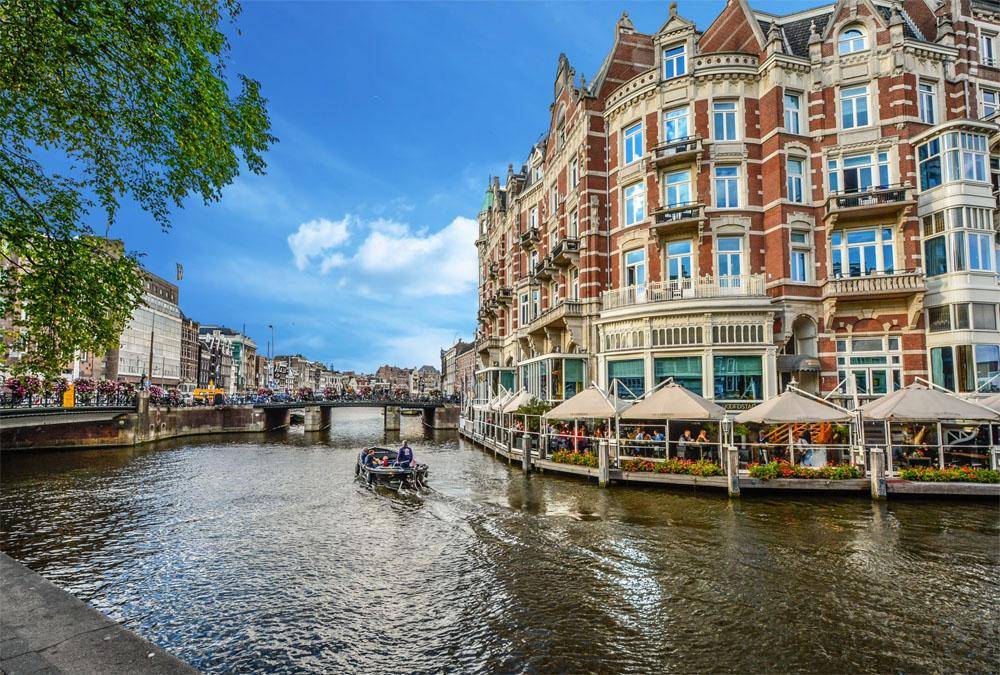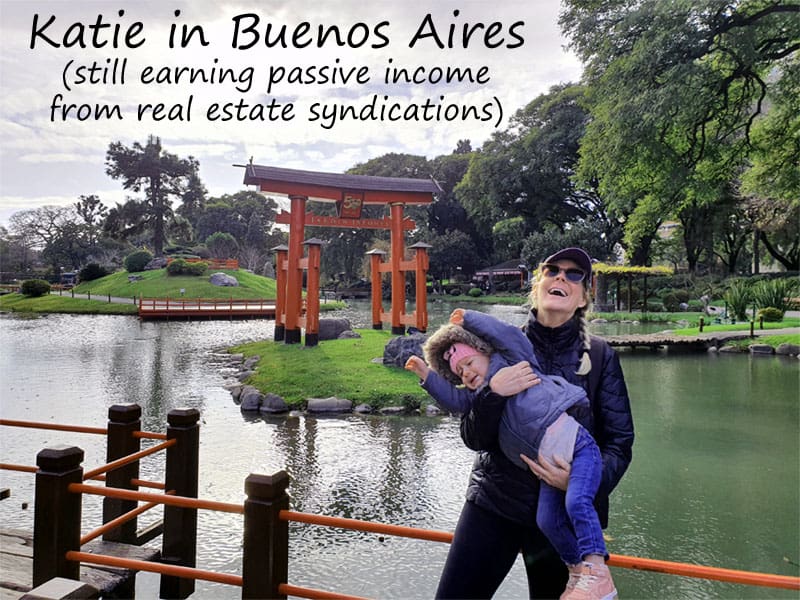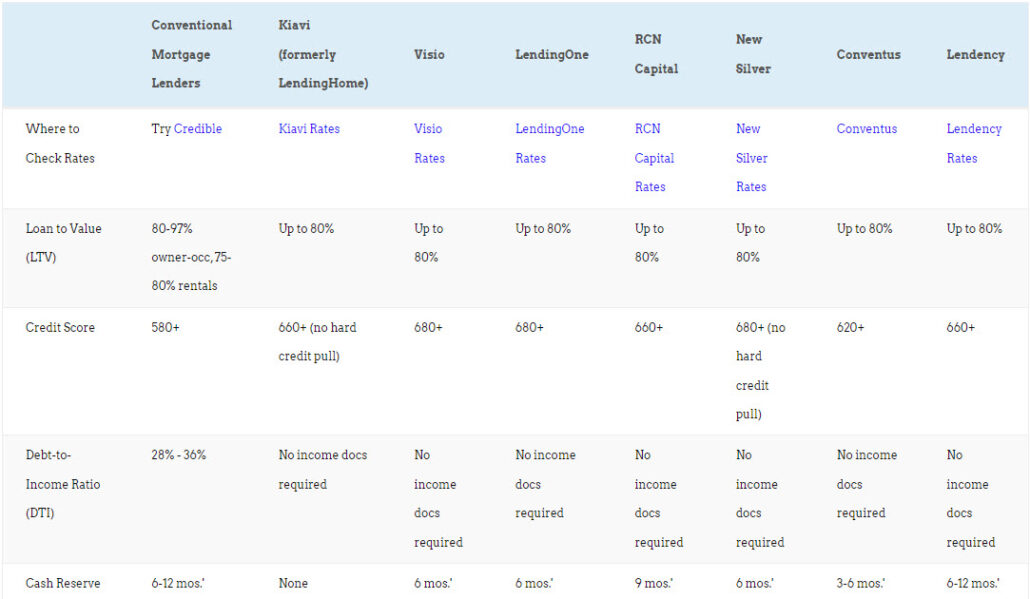
Martha and Terry live the dream.
They currently live on a houseboat, sailing the rivers of Europe. From the canals of Amsterdam to beautiful Strasbourg, France, the retired couple has enjoyed waterfront living all over Europe.
How did they do it? And how can you do the same thing?
The short version is simple: Martha researched how to become a landlord along with her husband Terry, and now live entirely on the rental income from this one multifamily rental property.
And the crazy part? They’re living for less, on their beautiful houseboat in Europe, than they were previously in the US!
Martha and Terry asked that we not share their last name, so I’ll refer to them as “the Robinsons”. Here’s how the Robinsons bought their first rental property, became landlords, and retired to travel the world.
Life Before They Became Landlords
Martha and Terry have always lived frugally, saving a huge chunk of their paycheck. (If you haven’t noticed, this is a common theme among people who retire young or reach financial independence from rentals! Look no further than how Ashley and Kevin Thompson retired with rentals by 30.)
“Terry and I always participated in our employer savings plans and always contributed the maximum amount. I don’t think we are particularly good savers or budgeters. But saving money, 401(k)s, Thrift Savings Plans, IRAs, and SEP IRAs — it was easy because our employers took it out of our paychecks and we never got our hands on it!”
That’s the trick to a high savings rate: not relying on discipline. Automate your savings if you want an exceptional savings rate, such as living on half your income or using a savings automation app like Acorns.
A high savings rate means, of course, living on less than you “can afford” to live on. “When we went to buy a home, our banker told us we could easily qualify for a $750,000 home loan. We were horrified beyond words at the thought of being responsible for that large of a loan. We bought a $275,000 house which was really quite nice.”
Nor does living on less end with real estate. “With cars, we would buy a good one, pay cash for it, and typically drove it for ten years.”
In fact, the Robinsons were so comfortable with their high savings rate that they decided to take a four-year sabbatical from their careers and sail the world.
A First Taste of Freedom: The 4-Year Sailing Sabbatical
It’s amazing how often I hear people say “Well, going off and traveling the world sounds great and all, but I have young children, and a job, and responsibilities.”
Sound familiar?
The Robinsons had all of those. It didn’t stop them.
“We took a mid-life, four-and-a-half-year sabbatical and sailed around the world aboard our 35-foot sailboat. We funded that trip with our IRAs.”
The kicker? They took their 11-month-old daughter with them. I myself live overseas with my three-year-old daughter.
“We lived on an average of $25,000/year. We did pay the 10% penalty for early withdrawal. But hey! Sailing around the world — 10% is an easy penalty to pay.”
This was before Martha and Terry bought their first rental property, had to sell off equities from their IRAs for cash to live on.
“The sailboat, fully tricked out, cost $85,000. Oddly enough, that is exactly what we sold her for at the end of our circumnavigation!”
And circumnavigation it was. After starting in Europe and the Mediterranean, and spending their first onboard winter in Malta, the Robinsons “turned west and never looked back. Back through the Greek islands, around Italy, the Spanish Balearics, through the Straights of Gibraltar to the Spanish Canary Islands. Then across the Atlantic (19 days) then we spent six months cruising in the Caribbean.
“From there we went through the Panama Canal, the Perlas Islands and an eight-day sail to the Galapagos Islands. Then a 19-day sail across the Pacific to the Marquesas, Tuomotus and Tahiti. We waited out the cyclone season in New Zealand.”
And so it went, for four amazing years.
The Decision to Buy Real Estate
Eventually, the Robinsons settled back down again in the U.S. and bought a home in Anchorage, Alaska. They enjoyed a tranquil ten years there, then were jolted awake, financially speaking.
“The 2008 crash was a wake-up call for us. Leaving our retirement savings in the stock market and hoping for the best was too risky. Our retirement savings in stocks took a hit like everyone else. And we were helpless fools in the whole debacle.
“Now real estate was something tangible; something we understood much better than the financial markets. So, in 2012, we took the plunge, aggregated our retirement accounts and funded a real estate LLC, held in trust for us by our self-directed IRAs.”
Screech! Stop the record. They did what? How did they buy a rental property in their IRA again? Trust? LLC? Huh?
When you open a self-directed IRA, you can invest in almost anything you want, including real estate. Some members of our Co-Investing Club invest in group real estate investments with a self-directed IRA. Read up on exactly how Martha invested in a rental property with a self-directed IRA for all the details.
How They Bought Their First Rental Property
“We, or technically our self-directed IRA, bought a little apartment building in Seattle, paying cash for it.
“We figured that there was very little downside to it. Even if the Seattle economy went flat or downturned, we could just lower the rents. No drama, just a lower return.”
Unlike mutual funds, ETFs, derivatives, and the like, rental properties were something the Robinsons felt confident investing in. “Returns based on the local demand for housing; this is something we could understand. And it was extremely low risk because no debt was involved.
“We chose Seattle because we perceived it to be a more stable market than Anchorage. We lived through the Alaska economic disaster of the 1980s when the price of oil dropped. It was too risky. Seattle was close, we had both lived there, and were generally familiar with the city.
“We wanted a stable neighborhood, a building in our price range (up to $850,000), a minimum return of about $40,000/year, and good condition. So we bought a five-unit multifamily property in Greenwood, built 14 years earlier, for $810,000.
“The units are all two-bedroom, two-bath, with a washer and dryer and off-street parking. When we bought the building, the rents were averaging around $1,200/month. They are now averaging around $1,700 to $1,800 per month. The rents could probably go a couple of hundred higher, but the tenants are good and we have low turnover.
“So, we grossed $108,000 and after expenses such as taxes, property management, maintenance, vacancy rate, and utilities, we netted $63,000 last year.”
Financial Independence, Early Retirement
After becoming landlords, Martha and Terry continued working. In fact, even though they had sold most of the equities in their IRA to buy a first rental property, they spent the next few years replenishing the equities in their retirement accounts.
Then the price of oil crashed, and they started getting jittery about their home’s value in Anchorage. “The economy in Anchorage is heavily dependent on oil, and Alaska was starting to see an economic downturn similar to the late 1980s. Layoffs were starting to roll around, new home starts dropped dramatically, businesses were closing, etc. We decided to sell the house, even though we didn’t want to move yet. We had some significant equity in it; we didn’t want that equity to evaporate.
“About six months after the house sold, my project management work was drying up. Frankly, with the house sold, no debts to carry, and a nice income from the self-directed IRA, we were free birds! Neither of us could think of a good reason why we should try to start over someplace else.
“So, we decided to retire early.”
The Problem of Health Insurance
One question that many people who retire early with real estate face is what to do about health insurance. “Unless provided through an employer, marketplace health insurance in Anchorage is ludicrously expensive. It would have been north of $20,000 per year to insure just me. “So, I did a little research about expat health insurance in foreign locations and very quickly realized it was a heck of a lot cheaper everywhere else in the world. Terry and I now have a policy that covers all the normal wellness stuff, emergent care, hospitalizations, medical evacuations, etc. It’s un upper-end private policy for Europeans. And it cost $7,200/year for both of us. Boom! Do the math.” Yes, Martha and Terry are saving money, even as they yacht around Europe’s most famous cities and enjoy a waterfront view every evening from their deck.Moving onto a Boat in Europe (Again)
“Terry went on a buying trip last spring and got us a gorgeous Dutch steel cruiser. In the last 14 months, we have been touring Holland, Belgium, the UK, and France.” Like everything else about the Robinsons’ experience, from saving money to buying a first rental property, they went about it conservatively. “We didn’t go overboard with buying the boat. I think, all in, we spent about $70,000 for a 35-year-old boat. “We paid for it by withdrawing cash (rents that had accumulated) from our self-directed real estate IRA. And we’ll probably lose a little money when we go to sell her, maybe $10-15,000. But we’re happy to pay that ‘penalty’ for such a great adventure!” Actually, that’s not a penalty, it’s a housing expense, and a cheap one at that. The Robinsons have been sailing Europe’s waterways for the last 14 months. Imagine they sell their boat after two years of ownership, for a $10,000 loss. That puts their housing at $5,000/year, or $417/month. What kind of home can you rent or buy for $417/month? Certainly not a waterfront home in any of Europe’s best cities.What It Takes to Create Your Dream Life with Real Estate
For the Robinsons, financial independence and early retirement started with a different mindset around money than the Average Joe in this country. The Robinsons never thought in terms of “What’s the most I can afford to spend?” on a house or car or dinners out. They instead thought in terms of “What’s the least I can spend, and still be happy?” They don’t consider themselves hard-core personal finance experts or saving nuts. “Our story is more about avoiding mindless saving, financial commitments (no big house debt, car payments, etc.), and investments we don’t understand.” Second, it took a retirement investing mindset shift. They could have kept plugging money into mutual funds, planning on a 4% withdrawal rate in retirement. Instead they decided to learn how to become a landlord, to buy a first rental property despite not having any experience. It’s worth noting that, for all their legal and tax acrobatics in putting their rental property inside an LLC inside a trust inside a self-directed IRA, they didn’t have to do that. They could have bought their first rental property the old-fashioned way, and still have the lifestyle they have today. Martha and Terry face the same challenges as other expats (myself included), which mostly come down to missing family back home. “Our daughter is too far away, and Dad isn’t doing so great; I suppose those are my biggest complaints. With the advent of the Internet and Google Translate, you can hunt down and find just about anything you need. We still have our bank accounts in the U.S. and access funds through debit cards. For communications we just buy SIM cards for the country we are in, making sure there’s a good data pack. “It is hard to find peanut butter in some cities. Oh well!” I asked Martha for a final thought on their experiences over the last six years (yes, it’s only been six years since they went to buy a first rental property, subsequently reached financial independence from real estate, retired and moved abroad). “Do we have any regrets about our savings and investing? Only that we should have dumped Wall Street sooner!”♦ What are your dreams for financial independence from real estate? Want to travel the world? Stay put? Have already taken the leap to start diversifying your portfolio into real estate?More Ideas to Help You Reach Financial Independence with Real Estate
About the Author

G. Brian Davis is a real estate investor and cofounder of SparkRental who spends 10 months of the year in South America. His mission: to help 5,000 people reach financial independence with passive income from real estate. If you want to be one of them, join Brian and Deni for a free class on How to Earn 15-30% on Fractional Real Estate Investments.





























Truly inspiring! This couple’s story emphasizes smart financial planning and investments proves that with dedication, anyone can make their retirement dreams a reality.
Agreed Mary!
Approaching my 50s, and it’s exciting to think about the world-travel plans and early retirement made possible by real estate investments. Thoughts on rental properties versus real estate syndications for retiring early?
Real estate syndications are passive, making them much easier. But you still need to learn how to vet sponsors and deals. As someone who travels frequently, I no longer want to hassle with landlording, so I opt for syndications.
I spent a year living on a houseboat, loved it. Hoping to retire early to Europe myself and do it all over again.
Love it Shannon!
My dream has always been to travel the world and live abroad, and I regret not starting in real estate investing sooner. While you can certainly reach financial freedom with traditional investments like stocks and bonds, you can get there a lot faster if you think less conventionally.
I hear you 100% Lauren!
I want to do the same, but as someone who’s new to investing, I’m one of those eager beginners. So, where should I begin to follow in Martha and Terry’s footsteps and start my journey into real estate investing for financial independence?
First and foremost, decide if you want to invest actively or passively in real estate. If you just want to diversify into real estate, with all the cash flow, appreciation, and tax benefits, but without becoming a landlord, start with passive real estate investing. If you want a real estate investing side hustle, with total control over every investment decision, start learning how to find deals, finance them, manage contractors, etc. as an active investor.
Great story. Goes to show that a high savings rate and pursuing early retirement doesn’t mean giving up on exciting life experiences.
Absolutely Suzanne!